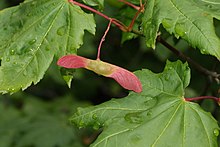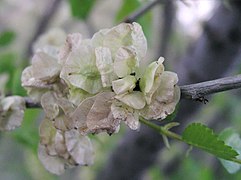Subtopic 1: Definition and Characteristics
– Samara is a winged achene type of fruit.
– The flattened wing of fibrous, papery tissue develops from the ovary wall.
– It is a simple dry fruit that is indehiscent.
– The shape of a samara aids in wind dispersal of seeds.
– Samara is a form of anemochory.
Subtopic 2: Seed Placement in Samaras
– In some samaras, the seed is in the center of the wing.
– Examples include elms, hoptree, and bushwillows.
– In other cases, the seed is on one side with the wing extending to the other side.
– This design makes the seed autorotate as it falls.
– Examples include maples and ash trees.
Subtopic 3: Variations in Samara Structure
– Some samaras have a single wing that enables fluttering.
– Species like Acer pseudoplatanus can produce samaras in groups of three or four.
– Mahogany samaras have a unique shape for fluttering.
– Sycamore maple samaras are typically in pairs but can also be in groups of three.
– Samaras are a source of amusement for tossing and watching them spin to the ground.
Subtopic 4: References
– The Oxford English Dictionary defines samara.
– Asa Gray’s “Botany for young people” discusses plant growth and structure.
– Charles Fergus’ book “Trees of Pennsylvania and the Northeast” includes information on samaras.
– David E. Alexander and Steven Vogel’s book “Natures Flyers” touches on biomechanics.
– Karl J. Niklas’ “Plant Biomechanics” provides an engineering approach to plant form and function.
Subtopic 5: Additional Information
– Samaras aid in seed dispersal by wind.
– The Woodland Trust website discusses seed dispersal mechanisms.
– The Wikipedia article on samaras is a stub that can be expanded.
– Samara is categorized under fruit morphology.
– It is also listed under fruit stubs and articles with short descriptions on Wikipedia.
A samara (/səˈmɑːrə/, UK also: /ˈsæmər-/) is a winged achene, a type of fruit in which a flattened wing of fibrous, papery tissue develops from the ovary wall. A samara is a simple dry fruit, and is indehiscent (not opening along a seam). The shape of a samara enables the wind to carry the seed farther away from the tree than regular seeds would go, and is thus a form of anemochory.


In some cases the seed is in the centre of the wing, as in the elms (genus Ulmus), the hoptree (Ptelea trifoliata), and the bushwillows (genus Combretum). In other cases the seed is on one side, with the wing extending to the other side, making the seed autorotate as it falls, as in the maples (genus Acer) and ash trees (genus Fraxinus).
There are also single-wing samara such as mahogany (genus Swietenia) which have a shape that enables fluttering.
Some species that normally produce paired samaras, such as Acer pseudoplatanus, can also produce them in groups of three or four.
-
Unusual group of three samaras of sycamore maple (Acer pseudoplatanus. Normally, they are in pairs.)
-
Seeds of the tropical ash (Fraxinus uhdei)
-
The hoptree (Ptelea trifoliata)
-
The Siberian elm (Ulmus pumila)




